Report from the International Division
Periodic exchange with Chinese Administrative Authorities Relating to Medical Devices and Visit to CMEF 2008 Exhibition
Introduction
The JIRA International Division visited China from April 15 to 22, 2008, to have periodic exchange of information and opinion with Chinese administrative authorities relating to medical devices, and to exhibit the JIRA booth at the 59th China International Medical Equipment Fair (CMEF 2008 Spring Exhibition) for the third time.
1. Periodic exchange with Chinese administrative authorities relating to medical devices
1.1 The International Exchange Center of Ministry of Health, P.R. China (MOH)
(1) Change of MOH organization and management
SFDA was integrated into the organization of MOH by the determination of the National People's Congress meeting (March, 2008). MOH/SFDA have own international exchange center organization respectively. They are performing their activities independently, because the contents of activities are different. The MOH International Exchange Center is performing an exchange activity with 100 or more countries and regions on a non-governmental basis, and focusing on exchange with Japan.
(2) Job of the MOH International Exchange Center
The government delegated the following work to the Center: the exit permit procedure (assistance to issuance of visa), a centralized purchase of medical devices, popularization of the healthcare train for emergency service, international medical assistance, etc. They already have three healthcare trains and plan to have the fourth in operation within this year. Additionally, they have an international liaison division and an internal affairs division (including Internet management division).
(3) The basic policy of MOH for the 2008 fiscal year is to ensure that all people can receive medical services impartially and reasonably. For that purpose, they will implement the following.
- To reform the control service of the public health project for rural areas where 80% of the population lives.
- To provide a medical service for local communities, such as counties, townships and towns.
- To construct small-scale community hospitals in urban areas.
*The Chinese tend to visit large hospitals, so it is necessary to reinforce the medical service of small-scale hospitals.
(4) The centralized purchase system for medical devices
- Through a centralized purchase, the aim is the effective use of healthcare expenditures. They have currently 200 to 300 bids a year. The introduction of a centralized purchase will reduce the number of bids and the cost. The purchase price will be decided reasonably and finance will be improved.
- MOH supervises directly 44 institutions nationwide. Not all of them are qualified for bidding. Bidding is limited to those hospitals that have installation qualifications for medical devices to be purchased by bidding.
- Even if any products are not accepted by the evaluation system, they are qualified to participate in the centralized purchase system.
- From June 2007, this system has been operated by MOH's International Exchange Center. The system is applied to large equipment of class A (an accelerator, the gamma knife, CT, etc.) and expensive products related to cardiology.
(5) The evaluation system for medical devices
- The evaluation system for medical devices is a license for medical devices for their reasonable use. They evaluate manufacturers, product performance and characteristics, etc.
- The period of validity of an approved license is, in principle, three years. There are opinions to shorten this period, and this matter is under examination now.
- It is not decided yet whether or not the Chinese Medical Equipment Association will evaluate medical devices in the 2008 fiscal year.
(6) The 17th China Hospital Equipment Exhibition (CHINA HOSPEQ 2008) (October 10 to 12, 2008)
- MOH is planning to have an exhibition with the same contents and scale as those in last year’s. They are examining to emphasize the features, such as the present situation of domestic medical devices. Moreover, as in last year’s, they are also examining the prospect of holding seminars to explain the New Five-year Plan, and to have specialized exhibit zones.
- MOH International Exchange Center expects to hold a joint technology exchange symposium with JIRA relating to innovative medical devices, such as the latest technical study meeting of CT. We will examine how JIRA can cooperate.
- We told them that JIRA would have an exhibit booth at this exhibition in line with last year’s.
1.2 The State Food & Drug Administration (SFDA) China Center for Pharmaceutical International Exchange
(1) Main job of the China Center for Pharmaceutical International Echange
- The China Drug International Exchange Center is under the control of SFDA. It covers drug and medical devices, and performs international exchanges with the U.S., Europe, Japan and other countries.
- It performs academic international exchange to hold symposiums, exhibitions, seminars, and consultancy for foreign companies that are to be registered in China.
(2) Role assignment of MOH and SFDA's International Exchange Center
The MOH International Exchange Center mainly performs international exchange about the management of healthcare systems. SFDA mainly performs international exchange about supervisory management of drug and medical devices.
(3) SFDA submitted the revision draft of the China Regulations on supervision and management to medical instruments to the State Council.
- The outline of the revision draft has been finalized. So, they explained that there would be no significant change in the law.
- In March 2008, a draft was submitted to the Legislative Affairs Office of the State Council. The State Council will proofread the draft, and ask for comments from related authorities. Then, SFDA will amend the draft again. It is scheduled to be effective by the end of 2008. But, much discussion is under way from different viewpoints, and the effective date may be postponed until the beginning of 2009.
- The present law consists of 6 chapters including 48 articles, but the draft version will increase significantly to 11 chapters including 126 articles. The concrete contents need to be investigated.
(4) The Administrative measures on examinations and supervision of imported medical devices(Degree. 95) was suspended by the order of the State Council (Legislative Affairs Office).
(5) Simplified application of class I products
Substantially, class I is handled by the application. Class I does not require any registration, clinical trial and reporting. The procedure ends when the registration division issues registration certificates. China does not have many class I products. Many class I products specified in Japan would be categorized as class II in China. Class II products must be subjected to strict examination.

2. The JIRA Booth Exhibition at the 59th China International Medical Equipment Fair (CMEF), 2008 Spring Exhibition.
(1) Period: April 18 to 21, 2008 at Shenzhen City New International Conference and Exhibition Center
(2) Number of exhibitors: About 2,000 exhibitors
(3) Number of visitors: About 40,000 people
Shenzhen City has developed into a major city as one of the most prosperous special economic zoness in China. The 59th CMEF 2008 Spring Exhibition was held there, in which JIRA participated again. JIRA displayed the devices of member companies and the panels of JIRA activities. Although a typhoon caused bad weather during the period, JIRA booth was visited by many people for agency negotiation, business talks, technical explanation of products, etc. and has obtained the foremost achievement. The contents of inquiries from visitors to JIRA booth became more concrete than before. JIRA exhibited previously (in Chengdu), and has been well known among Chinese exhibitors and Chinese dealers of medical devices. The future spring convention will be held constantly in Shenzhen City, which is easily accessible from domestic and abroad. On the other hand, the autumn convention will be held in one of local cities. The following exhibitions are scheduled in future.
- The 60th China International Medical Equipment Fair, Autumn Exhibition
o Venue: Suzhou City Suzhou International Expo Center
o Period: October 29 to November 01, 2008
- The 61st China International Medical Equipment Fair, Spring Exhibition
o Venue: Shenzhen City, Shenzhen City New International Conference
and Exhibition Center
o Period: April 18 to 21, 2009
Report from International Division
Periodic Exchange with Korean Administrative Authorities Relating to Medical Devices
and Visit to KIMES 2008
Introduction
The members of the JIRA International Division visited the Korean Food and Drug Administration (KFDA), Korean Testing Laboratory (KTL), Korean Medical Devices Industry Association (KMDIA), and Korean Medical Devices Industrial Cooperative Association (KMDICA) from March 15 to 21, 2008. We also conducted a survey of Korean Medical Equipment Law and a market survey about the Korean medical device market. We also inspected the Korea International Medical, Clinical, Laboratories & Hospital Equipment Show (KIMES 2008).
1. Exchange with Korean Food and Drug Administration (KFDA)
(1) Organization of KFDA
(2) Revision of Medical Equipment Law
We obtained information about the revision draft of medical equipment law and enforcement regulations that was published after March 2007.
(3) Clinical trial cases for medical devices in Korea (number of cases)
They reported that they have conducted about 70 cases in Korea over the past 5 years.
(4) Enforcement of EMC
- EMC has been enforced to "10 items" of the first designation since July 1, 2007.
- EMC has been enforced to class III and IV of the second designation since January 1, 2008.
- EMC will be enforced to "all products including class II" excluding class I starting in January 2009.
(5) Acquisition situation of KGMP
There are about 1,799 companies of medical devices. KGMP was acquired already by 1,332 companies (as of December 2007).
(6) The average number of days required for approval of medical devices counted from the date of application.
They finish the approval procedure within 30 days after application. They replied that the period does not exceed 30 days, except in special cases.
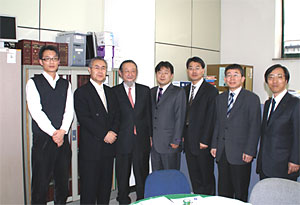 |
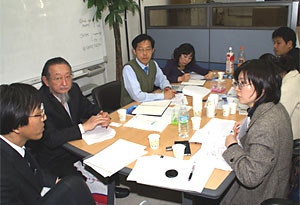 |
(Exchange with Medical Equipment
Safety-Countermeasure Section) |
(Exchange with Technical Document
Approval Assessment Team) |
2. Exchange with Seoul Regional Agency of Korean Food and Drug Administration (KFDA)(1) Top personnel affairs of KFDA
- "The Director General of KFDA" is appointed by the President.
- The positions of KFDA is in the decreasing order from the President to the Health and Welfare Family Division to KFDA.
(2) Authorized person for approval
- "The law" is voted and approved by the parliament.
- "The presidential order" is approved by the President.
- "The enforcement regulation" is approved by the Director General of the Health and Welfare Family Division.
- "The notification" is approved by the Director General of KFDA.
(3) About responsibility authority function of regional agency
- The regional agency accepts the (change) notice of manufacture/import items of medical devices.
- The regional agency conducts the administrative action to the notified matter manufacture/import items of medical devices.
- The regional agency supervises and regulates the factory, importer and repair firm of medical devices.
- The regional agency receives the report of repair firms.
- The regional agency issues the confirmation letter for experimental medical devices.
* Note: Medical-devices: The regional agency has full authority for class I.
3. Exchange with Korean Testing Laboratory (KTL)(1) Acquisition rate of GMP/GIP: About 92% (criteria in 2007)
- Number of manufacturers (including sales companies): 1,332 (criteria in 2007)
- Number of importers (including sales companies): 1,171 (criteria in 2007)
(2) About the criteria and control of the up-dating of application software for medical devices
- They explained the contents of software to be described in technical documents
- The above-mentioned contents are reflected in the case of item approval. When the manufacturers and importers have changed the contents submitted for approval, they must receive approval for the changed item.
- For further details, refer to "Assessment Guidelines for Medical Software" published by KFDA (2007. 10. 31).
(3) Independent certification of "application software" for medical devices
- In Korea, this kind of software is called "independent software", and corresponds to "software for image processing equipment for medical use (A26430)" class II.
- "Independent software" can be granted item approval independently. However, technical documents for item approval must describe the necessary operating environment of the software, that is, the hardware configuration.
- At present, there are many examples of approval of independent software.
(4) About EMC regulation
- EMC regulation is favorably carried out as scheduled by a notification, and there is no further information about a future work schedule.
- The schedule of EMC regulation is specified in the KFDA notification "the common standard for EMC safety of medical devices" (No. 2007-32, May 25, 2007).
- In the case of X-rays, the item approval is issued after EMC testing, starting from this year (2008). When an approval was granted last year (2007), and if the item has been changed, then a change item approval must be applied and approval must be granted. At that time, EMC testing is required.
- The simplified EMS testing is applied only to stationary medical devices. The related KFDA guidelines are posted on the KFDA web site dated March 13, 2008.
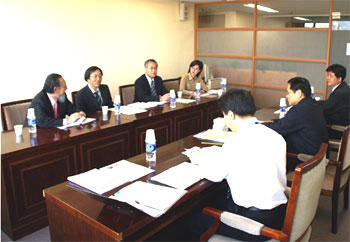 |
| (Exchange with KTL) |

4. Exchange with Korea Medical Devices Industrial Cooperative Association (KMDICA)
(1) The number of member companies of KMDICA increased from 283 to 318, that is, by 35.
Fiscal year |
2001 |
2002 |
2003 |
2004 |
2005 |
2006 |
Number of manufacturers |
1,025 |
1,177 |
1,446 |
1,668 |
1,788 |
1,752 |
Number of medical-device products |
6,447 |
7,659 |
9,300 |
10,927 |
12,193 |
12,712 |
Number of importers |
900 |
928 |
950 |
1,122 |
1,166 |
1,281 |
(2) When companies fail to acquire KGMP, they are prohibited to sell products, although they are allowed to manufacture them.
Fiscal year |
2001 |
2002 |
2003 |
2004 |
2005 |
2006 |
Ratio to
2005 |
| Domestic production |
995 |
1,073 |
1,331 |
1,478 |
1,635 |
2,074 |
126.9% |
| Export value |
445 |
461 |
515 |
569 |
699 |
817 |
116.9% |
| Import value |
884 |
1,028 |
1,140 |
1,284 |
1,509 |
1,799 |
119.2% |
| Domestic market |
1,434 |
1,640 |
1,956 |
2,193 |
2,445 |
3,056 |
125.0% |
(3) About the Korean medical device market
- The trend of manufacturers and importers of medical devices
- Medical-device market
* The overall market is growing, including the Korean domestic production, export and import values, and domestic markets.
* The domestic market increased to 125% compared with 2005.
* The Korean administration highly appreciates the medical device industry as "the next-generation industry."
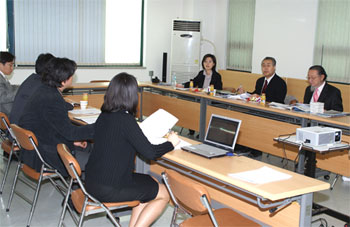 |
| (Exchange with KMDICA) |

5. Exchange with Korean Medical Device Industry Association (KMDIA)
(1) Change of KMDIA organization: personnel
- KMDIA secretariat staff increased to 18 by adding 3 people.
- Within KMDIA, there is a newly formed Advertising Prior Assessment Committee and its Secretariat.
- The Advertising Prior Assessment Committee consists of 13 persons.
- The Advertising Prior Assessment Committee Secretariat consists of 4 persons.
The Secretariat supports the operation of the Advertising Prior Assessment Committee and performs the related activities such as confirmation and notification.
(2) About the number of KMDIA member companies
- The number of member companies increased significantly from 285 (2006) to 514 (2008) by 229.
- Breakdown of member companies
|
Total |
Manufacturer |
Manufacturer
/ importer |
Importer |
Associate
member (sales) |
Special member |
| 2008 fiscal year |
514 |
97 |
77 |
247 |
91 |
2 |
| 2006 fiscal year |
285 |
41 |
50 |
171 |
21 |
2 |
Increase and decrease
of membership |
+229 |
+56 |
+27 |
+76 |
+70 |
0 |
* The manufacturers, importers, and associate members (mainly for sales) have increased significantly.
(3) Advertising Independence Deliberation Regulation was enforced from April 5, 2007, and its related work is handled by KMDIA.
(4) KMDIA gave us much data about the Korean medical device market. Most of the data is duplicated with the KMDICA data so KMDIA data is omitted in this report.
(5) Market information of dental diagnostic imaging equipment
Example of the dental X-ray generator (A11120)
| Fiscal year |
2004 |
2005 |
2006 |
Ratio to 2005 |
| Domestic production (1000 Won) |
3,739,814 |
2,091,903 |
2,535,978 |
121.2% |
| Export value (USD) |
294,744 |
821,870 |
1,575,189 |
191.7% |
| Import value (USD) |
6,841,875 |
5,759,383 |
1,258,507 |
21.9% |
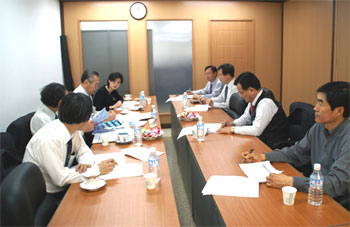 |
| (Exchange scenery with KMDIA) |

6. Inspection of the 24th Korea International Medical, Clinical, Laboratories & Hospital Equipment Show (KIMES 2008)
This is the largest international medical equipment exhibition in Korea where they desire earnestly for popularization and expansion of medical facilities. The 24th KIMES 2008 was held from March 13 (Thurs.) to 16 (Sun.) at the Seoul COEX International Exhibition Hall.
(1) Sponsorship:
Korea E & Ex Inc.
Korea Medical Devices Industrial Cooperative Association (KMDICA)
Korea Medical Devices Industry Association (KMDIA)
(2) Number of exhibition companies: 1,125 companies from 36 nations in the world displayed.
- Number of exhibition companies per nation:
Korea (545 companies), USA (164 companies), Germany (86 companies),
Japan (79 companies), China (38 companies), Taiwan (37 companies),
U.K. (20 companies), others
- Numbers of exhibition companies per items:
Physical medical treatment machines (198 companies), consumables for medical use (195 companies), medical consultation and diagnostic equipment (186 companies),
health-related equipment (150 companies), surgical instrument and appliances (128 companies), parts for medical equipment (97 companies), therapeutic equipment (85 companies), and emergency patient equipment (81 companies), radiation-related equipment (54 companies), clinical examination equipment (53 companies), herb-treatment equipment (51 companies), others
(3) Outline of the medical equipment companies that exhibited at the Clinical & Diagnosis Equipment Hall
- Korean major diagnosis imaging equipment companies:
LISTEM, Medison, Dong Kang Medical System, Medien International, Jawon Medical, Hanshin Medical, Choongwae Medical, GE Healthcare Korea, etc.
- Japanese companies:
ALOKA Korea, HITACHI, Toshiba Electron Tube, Fukuda Denshi, Nihon Kohden Korea, etc.
- Exhibition by agent: Shimadzu Corp. and Konica Minolta MG, etc.
- There were many products displayed by the companies related to the Wonju medical equipment special development area.
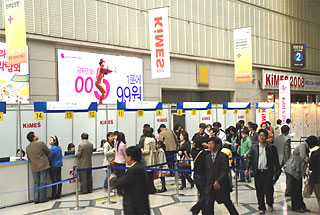 |
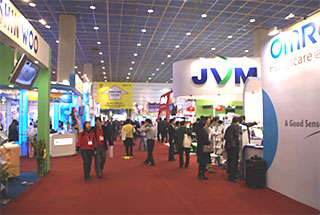 |
| (KIMES2008 reception desk on the final day) |
(KIMES2008 exhibition site on the final day) |
Medical Imaging System Division
DICOM Standards Committee (Chengdu City, Sichuan, China)
Participation Report
The DICOM Standards Committee (DSC), which controls and maintains DICOM standards, held a meeting in Chengdu City, Sichuan, China on April 11, 2008.
Positioning of DSC
DSC is the highest legislative organization that performs the overall supervision and orientation about the establishment and maintenance of the DICOM standards, and about the activity of the individual Working Group (WG). Although the DICOM standards have already covered an extensive range, new techniques and information are being defined additionally to meet technical advances. Moreover, the spelling errors of the text of a huge number of pages are being corrected, and expressions modified to make the text easier to read. Additions, corrections and modifications are being carried out from time to time.
Major corrections are proposed by DSC as the New Work Proposal (NWP) from the WG that is in charge of the project. Whether the correction should be started is determined by taking a show of hands. Minor corrections are submitted by the WG (mostly an individual who found mistakes) as Correction Proposal (CP). The contents of correction is confirmed by DSC, and sent to all the members by the secretariat as voting mail (Ballot).
Thus, DSC approves voting for every procedure, including major change of standards and minor correction of spelling error. Finally, all the members vote and reflect the change on the DICOM standard. It is a very democratic process. However, the DSC meeting is held three times per year so, the WG-06 meeting is held actively to bridge the gap.
Asia Region 2008 DICOM Standards Committee
The DSC meeting is held once a year in North America, Europe, and Asia, respectively, so three times a year in total. DSC 2007 was held in Taiwan in March 2007. DSC 2008 was held in Chengdu City, Sichuan, China in April 2008. DSC 2008 was held on April 11 after the 2008 DICOM International Conference and Seminar was held on April 8 to 10. This was the first meeting in mainland China. The Conference and DSC meeting were arranged mainly by the Chengdu Technical University.
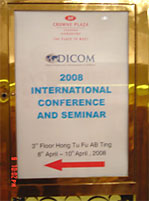 |
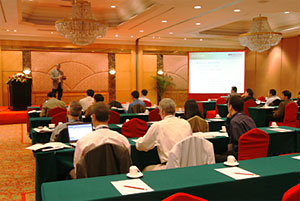 |
| Photo 1 |
Photo 2 DICOM INTERNATIONAL CONFERENCE |
From Japan, Sony Corp., Fuji Photo Film Co., Ltd. and JIRA participated.
One of the main agenda items was the strategy of how to familiarize more people with DICOM, which has become a substantial de-facto standard, and how to cooperate with the international standard organizations, the related academic societies, etc. Much time was spent for this discussion. First of all, the NEMA Legal Department proposed that the precautions to translate DICOM standard text into various languages should be included in the text itself (for example, the number of languages other than English to be used to write the precautions). This proposal was approved in principle. It was decided that the details should be proposed again by the Legal Department.
In ISO, several WGs of Technical Committee TC215 are working out the matters that are closely related with the medical telecommunications standards. The ISO activity is joined actively by DSC in charge of DICOM, Health Level Seven in charge of HL7 and other regional organizations.
Each WG under control of DSC reported a new work proposal and the progress of on-going work that can make DICOM easier to use, such as conversion of DICOM standard text into XML, standardization of a report (definition of the template), and standardization of animation compression. In the previous DSC meeting, Blu-Ray and HD-DVD were proposed as the large-volume media. But, the latter was withdrawn from the market. So, the standard itself will become simple.
Clinics and hospitals in several countries are exchanging CD media that comply with DICOM standard PDI (Portable Data for Imaging). But, ACR (American College of Radiology) reported various problems that were encountered in actual operation as follows. "DICOM specifies the so-called container, the media (physical specification and logical specification of data structure), and presents several examples of use (Use Case). However, data is written actually in many different ways, and the receiving doctors have trouble in using data effectively". Delivery of medical images by CD is carried out to some extent also in Japan. We felt that some guidelines need to be presented. We think that the sound popularity should be promoted by seminars that cover venders and users.
When each country presented a report, Japan presented the JIRA Report, which referred to the activity in Japan conducted since the previous DSC (November, 2007 @RSNA) and the participation in ISO/TC215.
As usual, many items of agenda were addressed. After that, reconfirmation was made about the next year's Asia Region DSC scheduled to be held in Kyoto in April 2009, and the meetings was closed (it was decided the meeting will be held in Germany in June and in the U.S. in December).
JIRA will become a host of 2009 Asia Region DSC (April 20 to 21 in Kyoto).
Education / Training Committee
Implementation of the 2007FY "Continuous Training Course"
Based on the Pharmaceutical Affairs Law
"Continuous Training Course" based on the Pharmaceutical Affairs Law is obligatory to the following persons: the business supervisor of a sales office for the retailer and rental dealer of a "specially controlled medical device", etc.; and the business supervisors of a sales office for the retailer and rental dealer as well as the responsible engineering manager of a repair firm of a "controlled medical device".
The course started in 2006 according to the provision of the Pharmaceutical Affairs Law.
JIRA implemented the course with the co-sponsorship of the following three associations: Japan Electronics and Information Technology Industries Association's Medical Electronic System Business Committee, Japan Industries Association of Medical Optical Device, and Japan Industries Association of Physical Therapy Device. The seven nationwide venues were Sapporo, Sendai, Tokyo, Nagoya, Osaka, Hiroshima, and Fukuoka.
The 2007FY Continuous Training Course
The first course was held in Tokyo in May. The courses ended at all the seven venues by September.
In the previous fiscal year, the lecturers were dispatched from four administrative authorities of Hokkaido, Miyagi, Hiroshima, and Fukuoka Prefectures, and they lectured about matters related to the Pharmaceutical Affair Law. In this fiscal year, we strongly requested that lecturers should be dispatched from Tokyo Metropolis, Aichi Prefecture, and Osaka Prefectural Government. As a result, Osaka accepted our request. In addition, lecturers were dispatched from JIRA and the three associations mentioned above to organize the lecturer team.
The contents of the training text were revised. The text has a new description of the revised Medical Service Law and the maintenance control. The text has an additional description of the Pharmaceutical Affairs Law, a nonconformity report, a recovery report, etc., which were explained insufficiently in 2006FY.
The number of trainees and graduates of each venue of Continuous Training Course in 2007 is shown in table 1. The total number of graduates was 1574 (cf. 2006FY: 1545).
Table 1
Venue |
Date (2007) |
The number of trainees |
Tokyo |
Mon. May 28 |
521 |
Osaka |
Thurs. June 14 |
300 |
Nagoya |
Tue. July 3 |
195 |
Sapporo |
Thurs. July 12 |
122 |
Sendai |
Tue. Sept. 4 |
123 |
Hiroshima |
Fri. Sept. 7 |
122 |
Fukuoka |
Fri. Sept. 21 |
191 |
Total |
1,574 |
The 2008FY Continuous Training Course
It is planned to be held at the seven venues nationwide as in the last fiscal year, as shown in table 2.
Talbe 2
| Venue |
Date (2008) |
| Tokyo |
Fri. May 23 |
| Osaka |
Tue. June 24 |
| Nagoya |
Fri. July 11 |
| Sapporo |
Tue. July 22 |
| Sendai |
Tue. Sept. 2 |
| Hiroshima |
Fri. Sept. 19 |
| Fukuoka |
Fri. Sept. 26 |
*) -- "The specially controlled medical device" is a risk class III device under the classification by the Pharmaceutical Affairs Law, whose risk is significant to human life and health in the event of a malfunction of the device (for example, dialyzer, artificial bone, radiotherapeutic equipment). |

